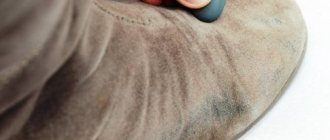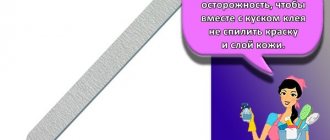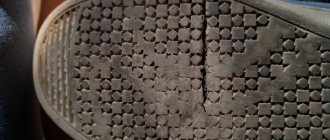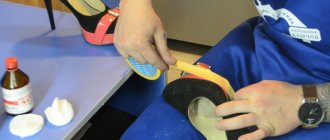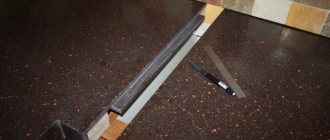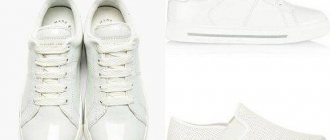Even the most expensive and high-quality shoes are damaged during wear from the influence of negative factors: dirt, moisture, reagents. Most often, the load falls on the sole and there is nothing left to do but go to the specialist. But there is no difficulty in doing everything yourself. Buying shoe glue is not difficult. But which one is the best among them and how to seal shoes so that it does not affect its appearance?
- Types of glue that are often used for shoe repair
- How to glue shoe soles?
- Shoe glue: brands for various materials
- How to glue the sole of a shoe with your own hands: cold and hot method
- Sports shoe repair: sealing the soles of sneakers
- What shoe glue to use to fix a hole in a sneaker?
- How to repair winter boots at home?
- Leather boots: how to restore their appearance?
- Resurrecting rubber boots
- How to restore the adhesive fastening of a sneaker using a patch
- Another way
- DIY boot repair: the best way
- How to fix shoes?
- The nuances of repairing shoes with voids
- conclusions
It is better to seek help from a professional. But what if your sole has come off and you have nothing else to wear? About 80% of shoes are created using a special reliable adhesive composition. Craftsmen also use them to restore the integrity of a product received for repair.
In this article we will share valuable tips on how to glue the sole at home yourself, what kind of glue to glue the sole of a shoe with, and how to repair a boot if the sole has fallen off completely. Let's take a closer look at the types of materials that are used for gluing.
What kind of glue can you use to glue the sole of a shoe?
You need to be careful when choosing glue for shoes. Before purchasing, you need to find out whether it is suitable for repair. The following brands of glue are suitable for gluing:
- "Moment Marathon".
- "Desmokol."
- "Shoemaker".
- "Nairit."
- Epoxy resin.
- "Kedra Farben".
- "Bonicol".
"Moment Marathon" was developed specifically for shoe repair. The composition is resistant to moisture, frost and negative environmental influences. But we must take into account that it is not suitable for gluing polypropylene, plasticized PVC, styrofoam and polyethylene. You can wear shoes a day after gluing.
“Desmokol” is a transparent glue containing polyurethane, due to this you can repair suede shoes and glue PVC materials. It is sold in specialized stores and used in shoe workshops.
Polychloroprene rubber is contained in the adhesives “Sapozhnik” and “Nairit”. They are suitable for gluing leather materials. The composition dries in 1-2 days. They are used in professional workshops, since when repairing shoes, shrinkage remains minimal.
Epoxy resin is a durable, waterproof layer, so it is ideal for gluing soles. Used for repairing sports and casual shoes, it dries in two days, but gives minimal shrinkage.
"Bonicol" and "Kedra Farben" are imported adhesives developed specifically for the shoe industry. Suitable for working with natural and artificial leather, repairing heels and insoles.
The listed compositions contain flammable components, so leaving them close to a fire source is strictly prohibited. It is recommended to store the tubes out of the reach of children.
Shoe glue: brands for various materials
Wondering which adhesive is best for shoes made of a certain material? Let's take a look at the rating of high-quality special compounds for reliable bonding.
- KENDA FARBEN is a good shoe glue from an Italian manufacturer. It is considered universal and is excellent for gluing synthetic and natural leather. Copes with rubber, textile, wood, plastic, shotgun and metal products. It is often used by craftsmen when repairing boots, because the materials adhere quickly, and the seam is durable and moisture-resistant.
- UHU “SCHUH & LEDER” - this glue is actively used by shoemakers for gluing hard and soft materials. The seam has been characterized by increased elasticity for a long time. Resistantly withstands the negative effects of moisture, alkali and acid. It does not dry out for a long time and can withstand high and low temperatures. If the sole has burst, then using Uhu glue you can glue the separated parts together using the contact method. Use solvent reactivation or heat activation.
- Use professional EVA glue if you don’t know how to seal a hole in your shoes. It reliably connects corner and side cuts, porous surfaces of breaks. In addition, they can be used to glue the insole. This is a reliable waterproof product that does not flow under the influence of ultraviolet radiation and does not leave adhesive marks. Suitable for all types of materials except PVC.
- You can glue the polyurethane sole with Nairit Shoemaker. It is actively used in their work not only by shoemakers, but also by ordinary people. It has high strength and water resistance. Does not contain hazardous substances, therefore completely harmless to humans.
- Russian-made Contact glue has been popular for more than 10 years. This product is suitable for repairing leather, rubber, ceramic and porcelain products. With its help, it is possible to fill all the cracks and gaps. If we glue even heavily damaged parts, the seams will be almost invisible.
- The Henkel company suggests using Moment Marathon for repairing boots. This is a universal adhesive that is highly effective. Economical in consumption and convenient to use. It has fast adhesion and will only take a few hours to completely harden.
Which glue is better not to use?
To glue the sole, it is better to use adhesives designed specifically for this purpose. It is not recommended to use:
- ordinary PVA, since it is not waterproof, the sole will immediately peel off after getting wet;
- compositions from the “Superglue” category - the connection will be rigid, the shoes will deform, unable to cope with the heavy load, as a result the material will tear;
- adhesives for installing ceiling tiles - they cope with their main task, but leave stains, so the shoes become unwearable.
It is better to buy a suitable adhesive composition in a specialized store. It is necessary to select an option for a specific material so that the gluing is high-quality and accurate.
Is it possible to return shoes to the store if the warranty has not expired?
When a person buys shoes, he hopes that they will last at least one season, but in practice the situation is a little different. The reason for the unsuitability of the product may be a manufacturing defect. Things are always covered by a guarantee, so the buyer can return the shoes to the store, exchange the goods or return the money according to the law.
The guarantee is established in accordance with the requirements of the current law.
Also, according to the law, in 2021 the buyer has every right to obtain information about the manufacturer of the product.
The following information may be requested:
- address;
- product name;
- Work mode;
- availability of state registration.
Options for gluing soles
You can glue the sole using hot or cold methods. Each of them has its own pros and cons.
Cold way
To glue shoes using the cold method, you must perform the following steps:
- clean, degrease and thoroughly dry the steam to be worked with;
- carefully apply the selected adhesive;
- Press the elements to be glued firmly against each other, making sure that there are no voids left;
- place the shoes under pressure for the time required for complete gluing (indicated on the packaging, usually it ranges from 10 hours to 2 days).
The drying time is indicated on the glue packaging; if you ignore it and put the boots on faster, the sole will come off again.
Hot way
Suitable for repairing shoes with hard soles. The glue is applied evenly over the entire surface and dries within 30 minutes. After this time, use a gas burner or hairdryer to heat the sole, then press the upper part firmly against it, holding for 15-20 seconds. When using this method, you can put on shoes after 2 days.
The sole of a shoe bursts for various reasons – let’s find out.
Lately, quite often, we have to deal with a problem when the sole of a shoe bursts .
What’s interesting is that this happens regardless of the price of the shoes, which to some extent should characterize its quality.
If you notice a crack on the sole, then it appeared for at least several reasons.
And now we will look at the following:
- Why does the sole of a shoe burst?
- How to prevent this.
- And is it possible to restore a cracked sole?
Important tips for sealing soles
To glue the sole securely and for a long time, you will need a sharp cutting tool with a thin blade, a degreaser, sandpaper, and clean rags. Before work, it is better to prepare foam rubber, old newspapers, a spatula and a glue brush in advance; they may be needed at any time. Algorithm for gluing shoe soles:
- inspect and assess the extent of damage;
- remove metal heels;
- clean the surface from dirt, degrease it, carefully remove the remnants of old glue;
- dry well;
- sand the parts to be glued together;
- apply a thin layer of glue to both surfaces to be glued;
- wait 10 minutes until it dries a little;
- for elements with a porous base, the glue must be reapplied in a second layer.
It is recommended to carry out gluing in a well-ventilated area, since the glue contains toxic substances. During work, smoking or being near an open flame source is prohibited.
Gluing the soles at home?
To glue the sole on yourself, you need to follow simple instructions:
- Thoroughly clean the damaged boot and dry it completely.
- Carefully inspect the sole; if it comes off in several places, it is better to tear it off completely and re-glue it. In addition, some shoes have honeycomb soles, which require special care.
- Using a spatula, clean the surface of old glue and degrease (acetone or alcohol).
- Apply sole glue to both surfaces according to the instructions. Most often we are talking about a thin layer of glue - no more than 3 mm.
- Wait a few minutes and press the sole firmly against the shoe so that there are no gaps between them.
- Secure the boot in this position for at least 10 hours. You can put a weight on top, having first tightly stuffed the boot with paper or newspapers so that it does not lose its shape. The second option is to fasten the seam with clothespins, just be careful not to scratch the skin.
The described method is called cold. The hot method differs only in that the applied composition must be left until completely dry (about half an hour), and then heated with a hairdryer and pressed firmly onto the surface for 20 seconds. You can wear repaired shoes after two days.
Video instruction:
How to seal a hole in a sole
Holes often form on shoes with soft soles. Regardless of its size, the product must first be cleaned, degreased, and dried well. After completing these steps, the hole is sealed with glue. If the hole is large, then a fiberglass mesh is placed in it. The sole is sealed with construction tape so that no bumps form on it and it remains level. Remove it after the glue has completely dried. To fill holes in the sole, it is recommended to use American polyurethane Seam Grip; an alternative is DoneDeal epoxy resin.
Why does the sole crack?
The base of shoes is often exposed to slush, frost, rain and chemicals. Due to mechanical loads, deformation occurs. Therefore, when making soles, special requirements are placed on the choice of material. It must be durable with maximum resistance to humidity and temperature changes. Products made from polyvinyl chloride are considered less elastic, so cracks appear during strong bending.
The next reason that the sole cracks is thickness. Very often, manufacturers use microporous rubber. If it is of poor quality, then after a couple of socks the first damage will appear. Also, the sole is made of polyurethane, which is prone to destruction. This can happen even if the shoes have not been worn.
The most common reason is various mechanical damage. While walking, a man stepped on a sharp object, and after a while a crack appeared. If you do not take any action, then dirt, dust and chemicals gradually accumulate in the fractures. The crack will get bigger each time, and eventually the shoes will become unusable.
How to properly seal a sole with voids
You can seal a sole that has voids using the following instructions:
- clean and degrease the surface;
- carefully fill the voids with microfiber scraps;
- seal everything with sealant;
- after it hardens, degrease the surface again;
- glue the upper part of the shoe with the sole using the instructions above.
You can use adhesives not only to glue the top and bottom of shoes, but also to prevent them from slipping in winter. To do this, a pattern is applied to the sole with glue, after it dries, it is processed with sandpaper.
How to glue shoe soles?
Before sealing your boots, you should assess the damage and choose the most optimal remedy to repair the damage. An effective shoe glue must have the following qualities:
- long service life;
- reliability;
- water resistance and frost resistance;
- reliable gluing regardless of the thickness of the materials used;
- minimal rigidity;
- elasticity.
It is true that, in the absence of more suitable means, shoes can be sealed with sealant. However, with its help you will not achieve the necessary adhesive strength. In addition, if used carelessly, it can ruin the appearance of the product.
Many types of glue have the necessary properties, but not all of them can glue leather to polyurethane, rubber or PVC. Therefore, before purchasing adhesive of a particular brand, carefully read the instructions for use.
Shoe sole glue
We have already said that not every shoe glue is suitable for gluing the sole to the top, but this largely depends on the sole itself.
We recommend: Methods for cleaning winter shoes from reagents and salt
To choose the right composition, you need to know about the compatibility of glue and materials.
- Polyurethane and vinyl soles will only be glued with Desmokol or other polyurethane glue.
- Rubber soles, as well as natural soles made of wood and leather, can be glued with both Nairit and Desmokol.
So it’s better to look at the label in advance to see what the soles of your sandals or sneakers are made of, so as not to waste money on the wrong glue.



